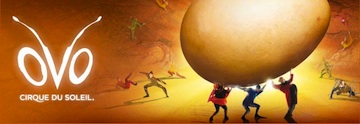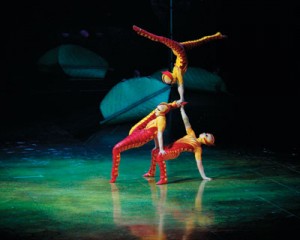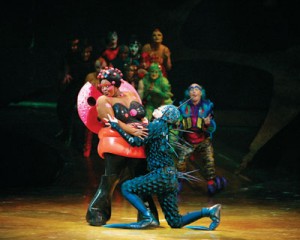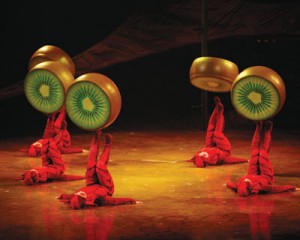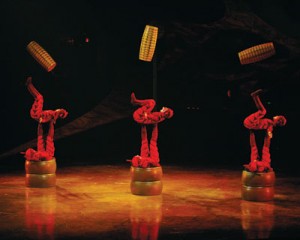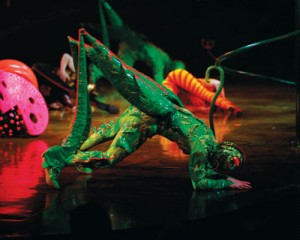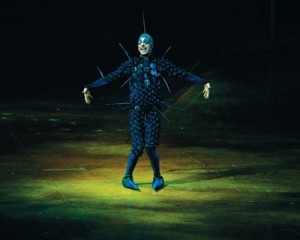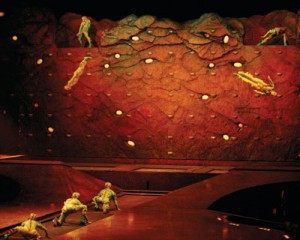IF THIS IS THE CIRCUS, WHERE’S MY BREAD?
In 1992, Guy Laliberté gentrified the big top with Saltimbanco, offering pure spectacle at Wagnerian prices, and in the process conflating art with acrobatics. Millions of people have subsequently made the same adjustment to their definition of quality entertainment. The change may be more significant than it seems, for while P.T. Barnum’s elephant Jumbo stole no business from Jenny Lind, today Kiri Te Kanawa competes directly with Cirque du Soleil. It isn’t much of a competition; for twenty years, the circus brand has suffered no rivals as the hottest ticket on the planet. Sophocles’ Oresteia had that honor during Western culture’s youth, but as society degenerated, audiences clamored for gladiators and freak shows. It may be instructive to remember that those audiences then plunged into a thousand-year Dark Age. 2009’s OVO (Portuguese for “egg”) is the latest Cirque tour to hit Los Angeles, and if it represents the new order of entertainment, prepare for apocalypse.
Much of the trapeze, juggling, contortion, and gymnastics in this show are extraordinary to look at. But if nothing else, OVO – a pageant of athletes wearing insect costumes – proves that superhuman feats are not inherently interesting. Each of OVO‘s two acts begins with ten grueling minutes of a gymnast doing handstands. Drama increases with difficulty, so the thrill factor fades once a performer establishes competence; Houdini’s crowds didn’t grow until he learned to make his escapes look like hard work. A handstand attempted by a gymnast may reasonably be expected to come off without a hitch, whereas a handstand attempted by, say, a middle-aged and not particularly coordinated theater critic would be (quite briefly) a dramatic and suspenseful spectacle. Imagine now that I had to do the handstand at gunpoint, and Voilà , you now have a narrative which might increase your interest (assuming you care whether I get shot). But ten minutes is a very long time to watch an expert sharpen her expertise’¦unless there’s a story involved.
Deborah Colker, who – as writer, director, and choreographer – dropped this ovo, seems to recognize story as a component necessary to compel the proceedings. In an uninspired dance number, she introduces a community of creatures, with three clowns as the primary characters. There’s a rudimentary love story and a rivalry of sorts, apparently over possession of a big egg that means much more to the 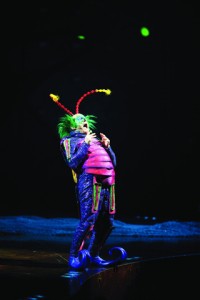 characters than to the audience. But the egg plot is summarily abandoned, and although at one point they attempt to kill one another, the rivals soon reappear, reconciled, with no transitional moment or gesture. Colker’s boredom with her narrative is further proved by the fact that none of the show’s specialty acts are related to it. Therefore the athletic exploits exist for no purpose but to amaze, which they might actually do if they were in service of that narrative, because then they would matter as more than a display of skill. Ah, well. These nits hardly deserve picking, given the primitive quality of what storytelling there is: someone gets kicked in the ovos (get it?); an obese black woman whips her head and shakes her finger (“Uh, uh, uh!”) in a display of attitude that was a stale stereotype in 1985. Bill Irwin or the New Bozena this is not. The clown segments of this production are reminiscent of nothing so much as old Mexican television: people dressed as bugs, hitting one another and making funny noises.
characters than to the audience. But the egg plot is summarily abandoned, and although at one point they attempt to kill one another, the rivals soon reappear, reconciled, with no transitional moment or gesture. Colker’s boredom with her narrative is further proved by the fact that none of the show’s specialty acts are related to it. Therefore the athletic exploits exist for no purpose but to amaze, which they might actually do if they were in service of that narrative, because then they would matter as more than a display of skill. Ah, well. These nits hardly deserve picking, given the primitive quality of what storytelling there is: someone gets kicked in the ovos (get it?); an obese black woman whips her head and shakes her finger (“Uh, uh, uh!”) in a display of attitude that was a stale stereotype in 1985. Bill Irwin or the New Bozena this is not. The clown segments of this production are reminiscent of nothing so much as old Mexican television: people dressed as bugs, hitting one another and making funny noises.
The most absorbing part of the show is trying to understand why people would pay this much to see it. The VIP tickets are $270 – only 150 for the kids! – and yet the bolo juggler dropped his instrument three times; a trapeze swinger fell; a foot juggler had to catch an object with her hands. Yes, these were exciting moments, but they were very clearly unintended, and without them the show would have been two and a half hours of well-oiled monotony. This kind of stupid cavalcade teaches audiences that expensive entertainment need not be good enough to hold their attention; in the middle of the first act, a woman beside me had to be scolded into putting her iPhone away (“Can’t believe we had to pay for parking. Max has the flu! Frowny face!” were among her urgent dispatches). Finally, after two and a half hours that denied the basic theatrical tenet of building to crescendo, a significant minority of the house crowded the exits before the dance finale was half over.
Asked outside the tent why she liked the show, a woman answered, “The costumes!” This sounds disingenuous, or at best faint praise for an orgy of physical prowess. But people must justify to themselves the things they do, the trends they follow, the expenses they incur. True, Liz Vandal’s costumes are beautiful, as are Berna Ceppas’s background songs and Gringo Cardia’s sets, but such things are the dressing, the trappings, the incidentals of real shows. Nonetheless, Cirque du Soleil powers forward on its signature formula, poised to destroy a second generation’s ability to distinguish top-of-the-line from run-of-the-mill. After civilization collapses as a corollary, we’ll have to watch Oedipus by candlelight, which might be a refreshing change after all.
photos by Benoit Fontaine
OVO by Cirque du Soleil
under the Big Top at Santa Monica Pier
scheduled to end on March 11, 2012
EXTENDED TO MARCH 25 in Los Angeles
open-ended tour continues
for cities, dates, and tickets, visit Cirque du Soleil/Ovo
